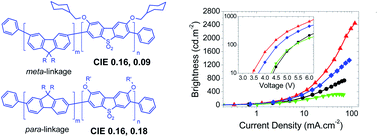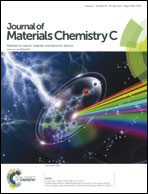Efficient deep blue fluorescent polymer light-emitting diodes (PLEDs)†
Abstract
A new series of deep blue/blue emitting co-polymers are reported. Poly(9,9-dihexylfluorene-3,6-diyl and 2,7-diyl-co-2,8-dihexyldibenzothiophene-S,S-dioxide-3,7-diyl) derivatives p(F-S) of varying composition have been synthesised. The effects of two different S derivatives with dialkoxy sidechains, the F : S monomer feed ratio, and meta versus para conjugation with respect to the F units have all been investigated in terms of photophysics and polymer light-emitting diode (PLED) device performance in the architecture ITO/PEDOT:PSS/polymer/TPBi/LiF/Al. The meta polymers poly(9,9-dihexylfluorene-3,6-diyl-co-2,8-di(O-methylenecyclohexyl)dibenzothiophene-S,S-dioxide-3,7-diyl) p(Fm-SOCy) in three different co-monomer ratios, P1–3, give deep blue electroluminescence peaking at 415 nm, with the ratio of 70 : 30 p(Fm : SOCy) producing a maximum external quantum efficiency (EQE) ηext, max 2.7%, whilst the ratio of 85 : 15 gave the highest maximum brightness Lmax of 81 cd m−2, with CIE coordinates (0.17, 0.12) The analogous para series poly(9,9-dihexylfluorene-2,7-diyl-co-2,8-di(O-methylenecyclohexyl)dibenzothiophene-S,S-dioxide-3,7-diyl) p(Fp-SOCy) and poly(9,9-dihexylfluorene-2,7-diyl-co-2,8-dihexyloxydibenzothiophene-S,S-dioxide-3,7-diyl) p(Fp-SO6) in two different ratios, P4–7, produced blue emission peaking at ca. 450 nm. The ratio of 70 : 30 F : S units consistently gave better devices than the corresponding 50 : 50 co-polymers. It was also observed that co-polymers incorporating the bulkier SOCy derivatives gave more efficient and brighter devices, with polymer P5 attaining a remarkable ηext, max 3.2%, 4.4 cd A−1, 3.4 lm W−1 and maximum brightness 2500 cd m−2 with CIE (0.16, 0.18).


 Please wait while we load your content...
Please wait while we load your content...